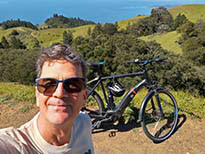* * *
Leaving San Francisco I encountered light fog outside my door -- the heavier stuff was below our 700-foot elevation. Looking up, I could even see a few stars. The fog wasn't too bad across the Golden Gate Bridge and over Waldo Grade, but it became a thick soup near the top of Highway 1 where it does the hairpin turn up to Panoramic.
Suddenly I could see only a couple of car lengths ahead. I'd pulled over earlier to let a faster car pass, and they were already long gone; no tail lights to follow. (A traffic sign down near Tam Junction had warned people that both Muir Woods and Stinson Beach were closed, by the way.)
I broke out of the fog somewhere above Muir Woods, and the view out the driver's side window looked so fine (see above) I decided to stop and await dawn's early light.
I could hear someone sneezing in one of the nearby homes across the street as I waited, watching the fog slowly move up the canyon, then back down, making it seem like the canyon itself was breathing. The sneezing reminded me of Pam, who was at home nursing a cold.
I was dressed warm in jeans and a fleece jacket. I had my coffee and a safe shoulder to wait on. But whoever lives in that sneezing house had an even better spot: their living room. Can you imagine having this view outside your living room window?!
The color started to get good right around sunrise, but the shift to dawn sent the fog right up the hill until it surrounded me. My perfect location was soon completely useless, obscured by fog.
I drove up the road a ways until I was above the fog once again and fired off a few frames with the 300mm. If you use a little imagination, you can just make out a faint orange tint across part of the fog bank.
Here's a scene I've seen countless times, but I still can't resist photographing it. Galen Rowell mistakenly calls the interesting, layered tree a Monterey pine in his excellent, must-have book Bay Area Wild, but it is a Douglas fir.
A bunch of little swallows were zooming overhead while I took in the gorgeous view. This is a composite photo showing several frames of the same bird as it flew by.
Continuing last week's acorn round-up, I wanted to photograph tanoak (named for its use in tanning animal skins)...
...and canyon live oak, or maul oak (named for its dense wood which was used to fashion mauls).
There were acorns galore, and them that eats acorns, like this Steller's jay.
I spent quite a bit of time just standing in the woods waiting for a bird to land near me, since chance favors the prepared photographer. Every now and then I'd hear a loud metallic thud as an acorn dropped onto the cars parked in the shade of the oak trees.
I could hear the red-breasted nuthatches calling from high in trees both near and far, but chance finally favored me when one of them flitted down to a nearby snag to work on ... a nest hole!
What the heck? In October? The bird was actively digging out the hole, pulling crumbs out with its beak.
Hard to imagine it's actually going to start raising young nuthatches, but time will tell.
I photographed this acorn woodpecker from nearly the same spot from which I'd watched the nuthatch. You gotta love that well-stocked larder. I saw a pair of ravens near the top of a different acorn-storage tree, and they appeared to be trying to prise acorns out of the holes. Leave it to a raven to try to steal what it could easily gather right off the ground.
I got out my Sibley and National Geographic bird guides to try to figure out which sparrow this is, and my guess is it's a youthful white-crowned sparrow. If so, they have a very sweet song that's quite different from the one we hear in my neighborhood and in Golden Gate Park.
Golden-crowned sparrow foraging in the moss.
When I bought my Nikon D800E (the one without an anti-aliasing filter), I wondered if I would run into moire problems photographing birds when I was close enough to capture feather detail. The image below is a crop from the (full-frame) image above.
Here's the close crop.
(Nikon 300mm f/4 w/ 1.7X teleconverter; 1/125th sec. @ f/6.7, ISO 1600)
Another golden-crowned sparrow perched on a lichen-crusted bay laurel.
I was originally attracted to the shadows of this fern on the rock in the background, as it made the rock look like a fossil.
Sunlight moves through the forest, briefly shining a spotlight on the same patch of deer ferns.
The "fossil" fern....
* * *





















































